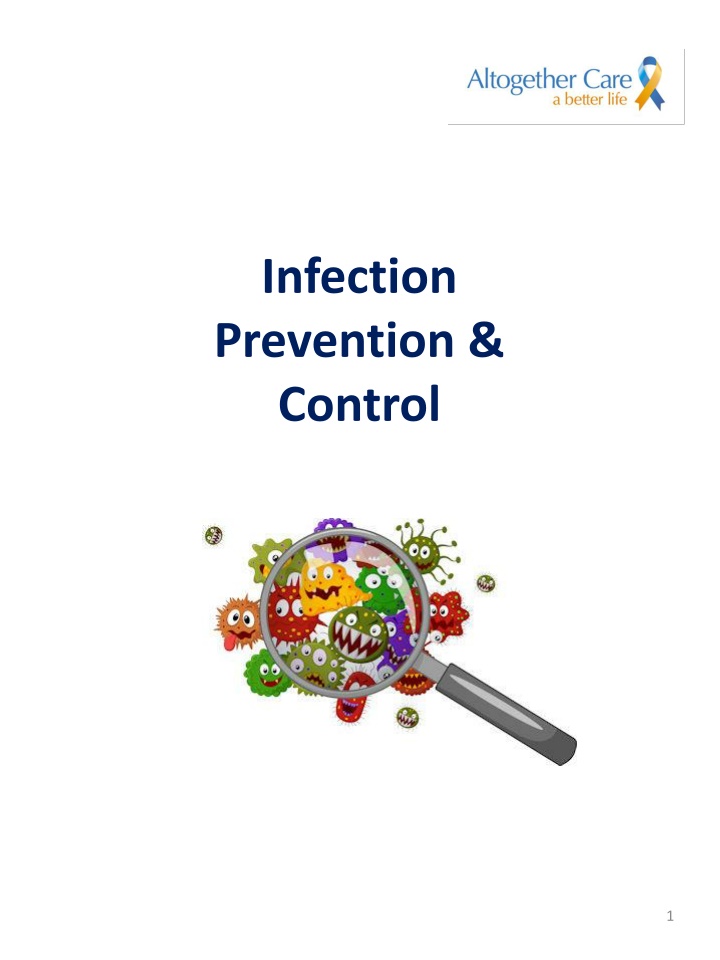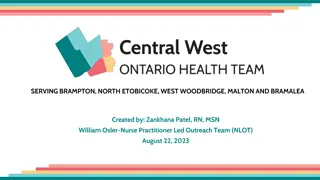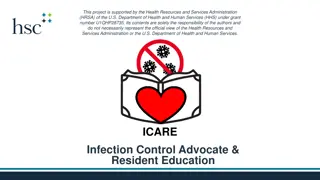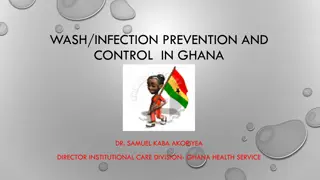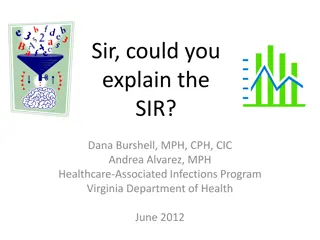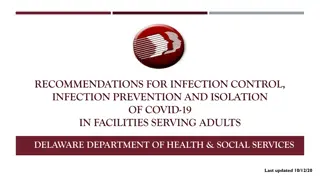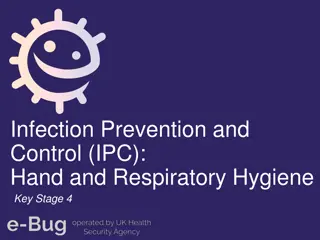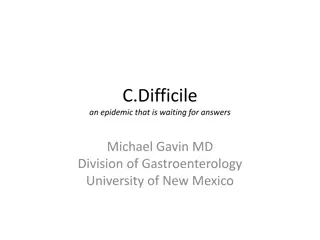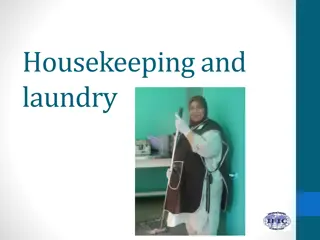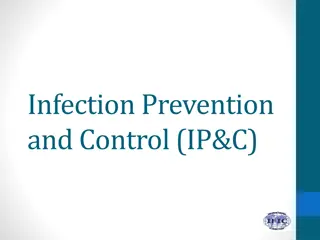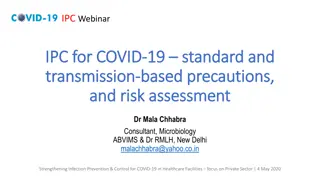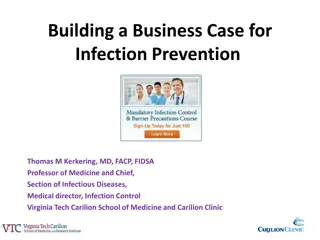Importance of Infection Prevention and Control in Healthcare
Infection Prevention and Control is crucial to safeguarding against the spread of harmful microorganisms in healthcare settings. This comprehensive guide covers the definition of infections, types of microorganisms, modes of transmission, the immune system's role, factors predisposing to infections, signs of infection, and preventive measures such as hand hygiene, PPE use, and disinfection protocols. By implementing these strategies, healthcare workers can protect both themselves and the individuals under their care from the risks of cross-infection.
Download Presentation

Please find below an Image/Link to download the presentation.
The content on the website is provided AS IS for your information and personal use only. It may not be sold, licensed, or shared on other websites without obtaining consent from the author.If you encounter any issues during the download, it is possible that the publisher has removed the file from their server.
You are allowed to download the files provided on this website for personal or commercial use, subject to the condition that they are used lawfully. All files are the property of their respective owners.
The content on the website is provided AS IS for your information and personal use only. It may not be sold, licensed, or shared on other websites without obtaining consent from the author.
E N D
Presentation Transcript
Infection Prevention & Control 1
What is infection? Infection is an attack on the body by micro-organisms There are many methods of becoming infected the most common is cross infection. Most times this is passed on by carers and outsiders. The best way to stop the spread of infection is to wash hands and wear personal protective equipment. You will be issued with gloves and aprons. Other PPE can be issued on request e.g. masks, shoe covers and sleeves. http://www.clipartbest.com/cliparts/7ca/Kbk/7caKbkaMi.jpeg Types of micro organisms: Bacterial Viral Fungal Parasites Protazoa Bacteria are found in the air, soil, water, food, and cavities of the body. They do not always cause disease. Examples are Staphylococcus, Streptococcus, E Coli, Salmonella. Viruses are smaller, disease causing organisms only seen by microscope which destroy the body s defences and can lie dormant in the body and reoccur later e.g. colds, flu, chicken pox, herpes. Fungal infections are mould like organisms only seen by microscope. They cause local infections in the mouth and other moist body surfaces e.g. ringworm and candida (thrush). Transmission Infections are transmitted by direct and indirect contact. Direct contact happens by touching, kissing, sexual contact, from mother to baby in the womb, contact with oral secretions and body lesions. Indirect contact happens by breathing in airborne diseases, touching objects which have been contaminated by infection, consuming contaminated food and drink, touching animals, insect bites. 2
The Immune System The body has a natural defence system which helps to prevent illness from infections. This consists of T cells White blood cells which are the core of the immune system, the skin this prevents infections from getting into the body, and the lining of the nose and mouth the mucous membrane which stops the pathogens getting into the body. The immune system is made up of a network of cells, tissues, and organs that work together to protect the body. One of the important cells involved are white blood cells, which come in two basic types that combine to seek out and destroy disease-causing organisms or substances. The stronger your immune system, the less likely that an infection will cause harm. The weaker your immune system the more chance of an acquired infection causing you to become very ill. Factors which may leave you open to infection. Age under 5 and over 65 Poor nutrition not getting the correct balance of nutrition Underlying medical condition Medication Low body temperature hypothermia The individuals we are caring for will probably be at risk of infection due to a number of these factors. Signs of Infection There are a number of indicators that an individual has an infection. It is important that care workers monitor the condition of their clients so that we can respond quickly to the signs of infection. Headaches Swellings Aches and pains Rise in temperature and pulse Discharge from wounds Change in behaviour Irritability Loss of appetite Unpleasant odours Prevention of Infection Something as simple as touching a doorknob, elevator button, light switch, or another person s hand increases the likelihood of coming in contact with germs that can make you sick. Simple precautions can prevent some disease transmission. 3 *Following legislation *Isolation of individuals *Safe food handling *Disposal of sharps * Hand washing * Wearing PPE * Using disinfectants and Anti bacterials * Cleaning up spillages immediately
It is important that all preventative measures are put into place to protect ourselves and the individuals we work with. Cross infection is the biggest risk to our clients. Hand washing is the most important preventative measure that we can take. 3 common infections we deal with Diarrhoea & Vomiting Scabies MRSA Diarrhoea & Vomiting Caused by gastroenteritis from different bugs, viruses, parasites and bacteria. Usually caught from food but can be passed directly from person to person. The main symptoms are diarrhoea, vomiting, stomach cramps, nausea and fever. Scabies Skin condition caused by a mite, the main symptom is itching, dry red patches between the fingers. It is very infectious but it can be treated by prescribed ointments. MRSA Methicillin resistant staphylococcus aureus is a germ carried in the nose of 20 40% of people. It is commonly found on the skin without causing any harm unless there is a skin breakage. It can be treated with combinations of antibiotics. If good hygiene practices are adhered to an MRSA client will pose no risk to anyone else. They can share a room and join in communal activities. Their care notes should be discreetly marked. Staff with eczema or psoriasis should not do any personal care. It is very important that these conditions are reported to the office so that preventative procedures may be put into place. KLOE Safe, effective and responsive ensure you attend your training. Ensure that you report any symptoms or changes in the care of your clients. Wear your PPE at the appropriate times. Follow your procedures to ensure solid infection control at all times. Identify and manage risks relating to infection control. Work together with your colleagues to ensure safe, effective and supportive care. 4
The urinary system Kidneys filter out waste products Ureters carry urine from kidneys to bladder Bladder reservoir & a pump to expel urine Urethra takes urine from bladder to outside the body Urine normal urine is pale yellow in colour dark urine means that there is an inadequate fluid intake cloudy, with offensive smell means there is probably an infection blood in urine means there is disease or damage to the urinary tract Causes of Incontinence Thee are many causes of incontinence physical or reduced mobility diabetes Psychological diseases MS, stroke, dementia social/environmental ageing process poor dexterity constipation limited fluid intake drugs injury to urinary tract Living with incontinence can be challenging but can be overcome by a number of methods. Incontinence pads are available in many shapes and sizes to suit individual needs. Catheterisation is a common method but is not suitable for all individuals, especially not for those who lack mental capacity as they may not understand why the catheter is in place and then try to pull it out, causing pain and damage to the urethra and bladder. 5
Urinary Catheters The Foley catheter is inserted into the urethra, a saline solution is injected through the catheter which inflates a balloon structure holding the catheter pipe in place. This is an invasive procedure carried out by a nurse. The bag attached to the catheter is emptied regularly by the care worker. The urinary sheath or convene is a non invasive way in which a catheter bag can be applied. The sheath can only be used for a maximum of 24rhrs. The penis should be washed and dried thoroughly before use. The sheath is placed on the end of the penis and unrolled down the penis with the finger and thumb. Care should be taken to ensure no hairs are caught and no wrinkles are present. The catheter bag is then attached to the end of the sheath. The catheter leg bag should be attached with privacy, dignity, care and compassion. Wash hands and apply gloves before application. Ensure the date is written on a new bag prior to application. After emptying ensure the tap is returned to the closed position . After removal ensure the bag is put in a bag and placed in an outside bin along with any other clinical waste. 6
The night bag is attached to the drain tap of the leg bag and the tap opened to drain the leg bag overnight. The night bag will hang from a frame under the bed or hanging from the bed frame. The date of first use should be written on the bag. It should be used for a maximum 7 days. Remove and drain the bag before performing personal care. Record amount if required , in the care notes. Replace the cap and store in a clean place for reuse. Dealing with contaminated waste: Pads faeces should be sluiced into the toilet. Pads folded inwards and placed in a plastic bag and disposed of in an outside bin. Catheter Bags, convenes, wipes, gloves and aprons - should be placed in a plastic bag, tied up and placed in an outside bin. Sharps should be placed needle first into a yellow sharps bin. Once full, inform district nurse for collection. Bedsheets remove any disposable incontinence sheets and sluice off any faeces. Ensure there are no personal effects hiding in bedding. Fold inwards and carry at arm s length directly to the washing machine. Do not allow to touch the floor as cross contamination could happen. Wash at high temperature and steam iron to kill any lingering bacteria. Contaminated clothing - wash at high temperature and steam iron. 7
